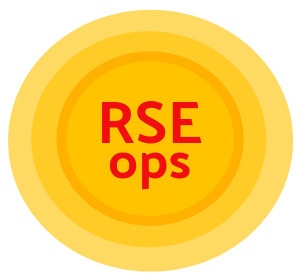
Maintenance for RSE-ops vs. DevOps
RSE-ops on HPC means that a number of systems are running all the time. They require a team to monitor, maintain, and take care of them. Cloud development does not require the resource requester to think about maintenance of a system any longer than the resource is needed. The resources are truly "on demand." An instance, or small container cluster, might be requested when it’s needed, and brought down and forgotten about when the work is done. This is a much easier interaction for the user, as they can request what they need when they need it. For a DevOps team, even if they are deploying container-based services, they don’t need to worry about long term care or maintenance of servers.
From the user perspective (the researcher or end-user of a cloud service), both HPC and cloud users don’t need to think about maintenance of the system. The resources are available and can be requested. Thus, the stark difference is that organizations with HPC typically host them on-premise, meaning that the organization needs to pay for everything from people to maintain and operate to the energy and cooling of the systems [1]. On the other hand, although operational costs might be reduced using a cloud resource, that cost can explode quickly depending on the kind and scale of cloud resource that is needed (e.g., GPUs) [2]. There is much knowledge in the HPC community about hidden costs from the cloud, and doing comparisons between cloud and on-premise to find that on-premise can be half the costs [3], [4]. One of the challenges is that the costs are constantly changing. Despite wanting to ultimately maximize profits, cloud providers typically provide cost calculators to help with this, provide free-tiers and "spot instances" at a lower cost, high use discounts, and do not charge for services (e.g., instances) that are turned off [5].
While we cannot suggest universal best practices for maintenance, it is logical that each institution needing resources do a cost benefit analysis to compare all options that meet a set of community needs. It might be more logical for small organizations (that perhaps cannot afford hosting and maintaining their own) to use cloud resources, and for larger organizations that are constantly using resources to host their own to save money.
- A. G. Carlyle, S. L. Harrell, and P. M. Smith, “Cost-Effective HPC: The Community or the Cloud?,” in 2010 IEEE Second International Conference on Cloud Computing Technology and Science, 2010, pp. 169–176. [bibtex]
- S. Li, R. J. Walls, and T. Guo, “Characterizing and Modeling Distributed Training with Transient Cloud GPU Servers,” in 2020 IEEE 40th International Conference on Distributed Computing Systems (ICDCS), 2020, pp. 943–953. [bibtex]
- T. P. Morgan and N. Hemsoth, “The Many Other High Costs Cloud Users Pay.” https://www.nextplatform.com/2021/06/25/the-many-other-high-costs-cloud-users-pay/, Jun-2021. [bibtex]
- “Magellan: A Cloud Computing Testbed.” https://www.nersc.gov/research-and-development/archive/magellan/. [bibtex]
- B. Power and J. Weinman, “Revenue Growth is the Primary Benefit of the Cloud,” IEEE Cloud Computing, vol. 5, no. 4, pp. 89–94, Jul. 2018. [bibtex]
